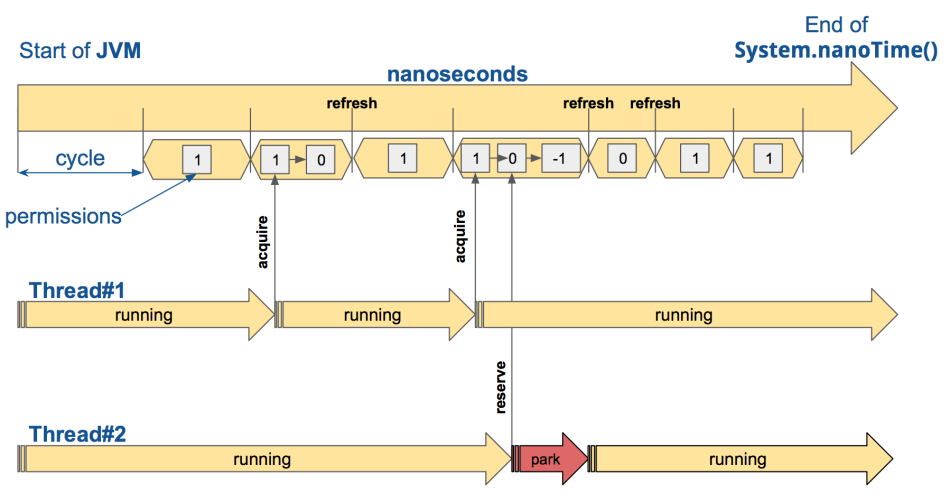Techniques for Configuring Executors and Guava RateLimiter for Effective Multithreaded Processing
 Tuanhdotnet
Tuanhdotnet4 min read

Source: Techniques for Configuring Executors and Guava RateLimiter for Effective Multithreaded Processing
1. Understanding Executors and Their Role in Multithreading
1.1 What is an Executor?
In Java, the Executor framework provides a high-level API for managing threads. Instead of manually creating and managing threads, the Executor handles thread lifecycle, task queuing, and execution policies. This abstraction simplifies multithreaded programming while offering flexibility to adapt to specific use cases.
1.2 Configuring Executors for Scalability
Let’s configure a ThreadPoolExecutor tailored for a high-load environment:
import java.util.concurrent.*;
public class ExecutorExample {
public static void main(String[] args) {
ThreadPoolExecutor executor = new ThreadPoolExecutor(
4, // Core thread pool size
10, // Maximum thread pool size
30, // Idle thread keep-alive time
TimeUnit.SECONDS,
new LinkedBlockingQueue<>(50), // Task queue
Executors.defaultThreadFactory(),
new ThreadPoolExecutor.CallerRunsPolicy() // Rejection policy
);
for (int i = 0; i < 100; i++) {
executor.submit(() -> {
System.out.println("Task executed by: " + Thread.currentThread().getName());
try {
Thread.sleep(200); // Simulate task workload
} catch (InterruptedException e) {
Thread.currentThread().interrupt();
}
});
}
executor.shutdown();
}
}
Explanation:
- Core Pool Size: The minimum number of threads always kept alive.
- Maximum Pool Size: The upper limit of threads to handle peak loads.
- Task Queue: Stores tasks waiting for execution. Here, a LinkedBlockingQueue with a capacity of 50 ensures tasks are queued before rejecting them.
- Rejection Policy: When the queue is full, CallerRunsPolicy executes tasks in the calling thread, providing a fallback mechanism.
1.3 Benefits of Using Executors
- Thread Reuse: Reduces the overhead of creating new threads.
- Task Management: Decouples task submission from execution.
- Customizable Policies: Offers fine-grained control over thread behavior and task rejection.
2. Introducing Guava RateLimiter for Flow Control
2.1 What is Guava RateLimiter?
Guava’s RateLimiter is a utility for limiting the rate at which tasks are processed. It ensures system stability by controlling the throughput, preventing resource contention, and maintaining predictable performance.
2.2 Configuring and Using Guava RateLimiter
Here’s an example of integrating RateLimiter with ExecutorService:
import com.google.common.util.concurrent.RateLimiter;
import java.util.concurrent.ExecutorService;
import java.util.concurrent.Executors;
public class RateLimiterExample {
public static void main(String[] args) {
ExecutorService executorService = Executors.newFixedThreadPool(5);
RateLimiter rateLimiter = RateLimiter.create(2.0); // 2 permits per second
for (int i = 0; i < 10; i++) {
executorService.submit(() -> {
rateLimiter.acquire(); // Block until permit is available
System.out.println("Task executed at: " + System.currentTimeMillis());
});
}
executorService.shutdown();
}
}
Explanation:
- Rate Configuration: RateLimiter.create(2.0) specifies a rate of 2 tasks per second.
- Permit Acquisition: The acquire method blocks the thread until a permit is available.
- Seamless Integration: Tasks are executed in a controlled manner without overwhelming the system.
2.3 Advantages of Guava RateLimiter
- System Protection: Prevents overloading shared resources like databases or APIs.
- Smooth Throughput: Ensures a consistent flow of task execution.
- Simplicity: Integrates seamlessly with existing thread pools.
3. Combining Executors and RateLimiter
3.1 Coordinating Task Execution and Rate Limiting
Here’s a practical example of combining Executors and RateLimiter for efficient task processing:
import com.google.common.util.concurrent.RateLimiter;
import java.util.concurrent.ExecutorService;
import java.util.concurrent.Executors;
public class CombinedExample {
public static void main(String[] args) {
ExecutorService executorService = Executors.newFixedThreadPool(3);
RateLimiter rateLimiter = RateLimiter.create(5.0); // 5 tasks per second
for (int i = 0; i < 20; i++) {
executorService.submit(() -> {
rateLimiter.acquire();
System.out.println("Task processed by: " + Thread.currentThread().getName() +
" at " + System.currentTimeMillis());
});
}
executorService.shutdown();
}
}
Key Considerations:
- Thread Safety: The RateLimiter ensures tasks adhere to the rate limit, even in multithreaded scenarios.
- Throughput Control: Balances task execution speed with system capacity.
4. Challenges and Best Practices
Challenges in Configuring Executors and RateLimiter
- Deadlocks: Improper queue or thread configurations can lead to deadlocks.
- Overhead: Using too many threads or high rate limits can increase system load.
- Latency: RateLimiter can introduce delays, which may impact real-time systems.
Best Practices
- Monitor Thread Usage: Use tools like JVisualVM to monitor thread states and adjust configurations.
- Tune RateLimiter: Set rates based on empirical data and adjust dynamically for varying loads.
- Fallback Mechanisms: Always define rejection policies or alternative flows to handle overloads.
5. Conclusion
Configuring Executors and RateLimiter for multithreaded processing is a powerful approach to achieving system stability and predictable performance. By combining their strengths, developers can create efficient, robust, and scalable applications. Understanding the nuances of thread pool management and rate limiting ensures you extract maximum value from these tools.
If you have any questions or want to share your experiences with Executors and RateLimiter, feel free to comment below!
Read more at : Techniques for Configuring Executors and Guava RateLimiter for Effective Multithreaded Processing
0
Subscribe to my newsletter
Read articles from Tuanhdotnet directly inside your inbox. Subscribe to the newsletter, and don't miss out.
Written by

Tuanhdotnet
Tuanhdotnet
I am Tuanh.net. As of 2024, I have accumulated 8 years of experience in backend programming. I am delighted to connect and share my knowledge with everyone.